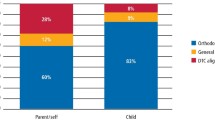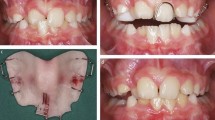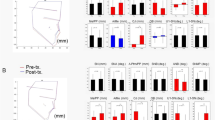Key Points
-
Discusses the rationale and indications for a combined orthodontic and orthognathic approach, in accordance with the recently introduced assessment of treatment need.
-
Provides a detailed account of the orthognathic patient journey, including the key stages of planning, orthodontic preparation, finishing and surgical approaches.
Abstract
Orthognathic treatment is a process which involves orthodontics and maxillofacial surgery and is used to treat those dento-facial discrepancies which are outside the scope of conventional orthodontic treatment, for example severe Class II or Class III problems, anterior open bites and facial asymmetries. Patients who present with these severe problems may encounter a wide range of different problems ranging from functional problems (for example, difficulties biting and chewing) to self-consciousness in a wide range of work and social situations. This paper discusses the possible indications for orthognathic treatment and looks at the risks and benefits of treatment. The treatment pathway is also described.
Similar content being viewed by others
Log in or create a free account to read this content
Gain free access to this article, as well as selected content from this journal and more on nature.com
or
References
Steinhäuser E W . Historical development of orthognathic surgery. J Cranio-Maxillofac Surg 1996; 24: 195–204.
Proffit W R, White R P Jr . Who needs surgical orthodontic treatment? International J Adult Orthod Orthognath Surg 1990; 5: 81–89.
Sandy J R, Irvine G H, Leach A . Update on orthognathic surgery. Dent Update 2001; 28: 337–345.
Templeton K M, Powell R, Moore M B, Williams A C, Sandy J R . Are the peer assessment rating index and the index of treatment complexity, outcome, and need suitable measures for orthognathic outcomes? Eur J Orthod 2006; 28: 462–466.
Ryan F S, Barnard M, Cunningham S J . Impact of dentofacial deformity and motivation for treatment: a qualitative study. Am J Ortho Dentofac Orthop 2012; 141: 734–742.
Seehra J, Fleming P S, Newton T, DiBiase A T . Bullying in orthodontic patients and its relationship to malocclusion, self-esteem and oral health-related quality of life. J Orthod 2011; 38: 247–256.
Al-Bitar Z B, Al-Omari I K, Sonbol H N, Al-Ahmad H T, Cunningham S J . Bullying among Jordanian schoolchildren, its effects on school performance, and the contribution of general physical and dentofacial features. Am J Orthod Dentofac Orthop 2013; 144: 872–878.
Macgregor F C . Social and psychological implications of dentofacial disfigurement. Angle Orthod 1970; 40: 231–233.
Lansdown R, Lloyd J, Hunter J . Facial deformity in childhood: severity and psychological adjustment. Child: Care Health Dev 1991; 17: 165–171.
Laufer D, Glick D, Gutman D, Sharon A . Patient motivation and response to surgical correction of prognathism. Oral Surg Oral Med Oral Pathol 1976; 41: 309–313.
Jensen S H . The psycho-social dimensions of oral and maxillofacial surgery: a critical review of the literature. J Oral Surg 1978; 36: 447–453.
Heldt L, Haffke E A, Davis L F . The psychological and social aspects of orthognathic treatment. Am J Ortho 1982; 4: 318–328.
Garvill J, Garvill H, Kahnberg KE, Lundgren S . Psychological factors in orthognathic surgery. J Craniomaxillofac Surg 1992; 20: 28–33.
Cunningham S J, Hunt N P, Feinmann C . Perceptions of outcome following orthognathic surgery. Br J Oral Maxillofac Surg 1996; 34: 210–213.
Williams A C, Shah H, Sandy J R, Travess H C . Patients' motivations for treatment and their experiences of orthodontic preparation for orthognathic surgery. J Orthod 2005; 32: 191–202.
Hunt N P, Cunningham S J . The influence of orthognathic surgery on occlusal force in patients with vertical facial deformities. Int J Oral Maxillofac Surg 1997; 26: 87–91.
Stirling J, Latchford G, Morris D O, Kindelan J, Spencer R J, Bekker H L . Elective orthognathic treatment decision making: a survey of patient reasons and experiences. J Orthod 2007; 34: 113–127.
Forssell H, Finne K, Forssell K, Panula K, Blinnikka L M . Expectations and perceptions regarding treatment: a prospective study of patients undergoing orthognathic surgery. Int J Adult Orthodon Orthognath Surg 1998; 13: 107–113.
Proothi M, Drew S J, Sachs S A . Motivating factors for patients undergoing orthognathic surgery evaluation. J Oral Maxillofac Surg 2010; 68: 1555–1559.
Alanko O M, Svedström-Oristo A L, Tuomisto M T . Patients' perceptions of orthognathic treatment, well-being, and psychological or psychiatric status: a systematic review. Acta Odontol Scand 2010; 68: 249–260.
World Health Organization. WHOQOL; Measuring quality of life. 1997. Available online at: http://www.who.int/mental_health/media/68.pdf (accessed 19 January 2015).
Lee S, McGrath C, Samman N . Quality of life in patients with dentofacial deformity: a comparison of measurement approaches. Int J Oral Maxillofac Surg 2007; 36: 488–492.
Rusanen J, Lahti S, Tolvanen M, Pirttiniemi P . Quality of life in patients with severe malocclusion before treatment. Eur J Orthod 2010; 32: 43–48.
Ireland A J, Cunningham S J, Petrie A et al. An index of orthognathic functional treatment need (IOFTN). J Orthod 2014; 41: 77–83.
Luther F, Morris D O, Hart C . Orthodontic preparation for orthognathic surgery: how long does it take and why? A retrospective study. Brit J Oral Maxillofac Surg 2003; 41: 401–406.
Luther F, Morris D, Karnezi K . Orthodontic treatment following orthognathic surgery: How long does it take and why? A retrospective study. J Oral Maxillofac Surg 2007; 65: 1969–1976.
Kiyak H A, West R A, Hohl T, McNeill R W . The psychological impact of orthognathic surgery: a 9-month follow-up. Am J Orthod 1982; 81: 404–412.
Morris D O . Improving standards in orthognathic care: the bigger picture (a national and international perspective). J Orthod 2006; 33: 149–151.
Loh S, Yow M . Computer prediction of hard tissue profiles in orthognathic surgery. Int J Adult Orthod Orthognath Surg 2002; 17: 342–347.
Power G, Breckon J, Sherriff M, McDonald F . Dolphin Imaging Software: An analysis of the accuracy of cephalometric digitization and orthognathic prediction. Int J Oral Maxillofac Surg 2005; 34: 619–626.
Jones R M, Khambay B S, McHugh S, Ayoub A F . The validity of a computer-assisted simulation system for orthognathic surgery (CASSOS) for planning the surgical correction of class III skeletal deformities: single-jaw versus bimaxillary surgery. Int J Oral Maxillofac Surg 2007; 36: 900–908.
Suri L, Taneja P . Surgically assisted rapid palatal expansion: A literature review. Am J Orthodont Dentofac Orthoped 2008; 133: 290–302.
Fedorowicz Z, Nasser M, Newton J T, Oliver R J . Resorbable versus titanium plates for orthognathic surgery. Cochrane Database Syst Rev 2007; CD006204.
Department of Health. High Quality of Care for all. NHS Next Stage Review Final Report. London: The Stationery Office, 2008.
Cunningham S J, Garratt A M, Hunt N P . Development of a condition-specific quality of life measure for patients with dentofacial deformity: II. Validity and responsiveness testing. Community Dent Oral Epidemiol 2002; 30: 81–90.
Esperão P T, de Oliveira B H, de Oliveira Almeida M A, Kiyak H A, Miguel J A . Oral health-related quality of life in orthognathic surgery patients. Am J Orthod Dentofacial Orthop 2010; 137: 790–795.
Murphy C, Kearns G, Sleeman D, Cronin M, Allen P F . The clinical relevance of orthognathic surgery on quality of life. Int J Oral Maxillofac Surg 2011; 40: 926–30.
Hunt O T, Johnston C D, Hepper P G, Burden D J . The psychosocial impact of orthognathic surgery: a systematic review. Am J Orthod Dentofacial Orthop 2001; 120: 490–497.
Soh C L, Narayanan V . Quality of life assessment in patients with dentofacial deformity undergoing orthognathic surgerya systematic review. Int J Oral Maxillofac Surg 2013; 42: 974–980.
Kiyak H A, McNeill R W, West R A, Hohl T, Bucher F, Sherrick P . Predicting psychologic responses to orthognathic surgery. J Oral Maxillofac Surg 1982; 40: 150–155.
Kiyak H A, Hohl T, West R A, McNeill R W . Psychologic changes in orthognathic surgery patients: a 24-month follow up. J Oral Maxillofac Surg 1984; 42: 506–512.
Øland J, Jensen J, Melsen B . Factors of importance for the functional outcome in orthognathic surgery patients: a prospective study of 118 patients. J Oral Maxillofac Surg 2010; 68: 2221–2231.
Magalhães I B, Pereira L J, Marques L S, Gameiro G H . The influence of malocclusion on masticatory performance. A systematic review. Angle Orthod 2010; 80: 981–987.
Vicini C, Dallan I, Campanini A et al. Surgery vs ventilation in adult severe obstructive sleep apnea syndrome. Am J Otolaryngol 2010; 31: 14–20.
Holty J-E C, Guilleminault C . Maxillomandibular advancement for the treatment of obstructive sleep apnea: A systematic review and meta-analysis. Sleep Med Rev 2010; 14: 287–297.
Flanary C M, Alexander J M . Patient responses to the orthognathic surgical experience: factors leading to dissatisfaction. J Oral Maxillofac Surg 1983; 41: 770–774.
Flanary C M, Barnwell G M Jr, Alexander J M . Patient perceptions of orthognathic surgery. Am J Orthod 1985; 88: 137–145.
Cunningham S J, Hunt N P, Feinmann C . Psychological aspects of orthognathic surgery: a review of the literature. Int J Adult Orthodon Orthognath Surg 1995; 10: 159–172.
Chen B, Zhang Z K, Wang X . Factors influencing postoperative satisfaction of orthognathic surgery patients. Int J Adult Orthodon Orthognath Surg 2002; 17: 217–222.
Cunningham S J, Sculpher M, Sassi F, Manca A . A cost-utility analysis of patients undergoing orthognathic treatment for the management of dentofacial disharmony. Br J Oral Maxillofac Surg 2003; 41: 32–35.
Panula K, Keski-Nisula L, Keski-Nisula K, Oikarinen K, Keski-Nisula S . Costs of surgical-orthodontic treatment in community hospital care: an analysis of the different phases of treatment. Int J Adult Orthodon Orthognath Surg. 2002; 17: 297–306.
Travess H, Roberts-Harry D, Sandy J . Orthodontics. Part 6: Risks in orthodontic treatment Br Dent J 2004; 196: 71–77.
Sousa C S, Turrini R N . Complications in orthognathic surgery: A comprehensive review. J Oral Maxillofac Surg Med Pathol 2012; 24: 67–74.
Iannetti G, Fadda T M, Riccardi E, Mitro V, Filiaci F . Our experience in complications of orthognathic surgery: a retrospective study on 3: 236 patients. Eur Rev Med Pharmacol Sci. 2013; 17: 379–384.
Proffit W R, Turvey T A, Phillips C . The hierarchy of stability and predictability in orthognathic surgery with rigid fixation: an update and extension. Head Face Med 2007; 3: 21–32.
Acknowledgements
Many thanks to the patients who allowed their photographs to be used in this publication. Thank you to: Mr Tim Lloyd (Maxillofacial Surgeon, Eastman Dental Hospital, UCLH Foundation Trust) who undertook the surgery for the patients whose photographs are shown in Figures 1, 2, 3, 7 and 8, and also to Mr Neil Patel for the photographs in Figure 2 and Mr Tom McDonald for the photographs in Figure 5.
Author information
Authors and Affiliations
Corresponding author
Additional information
Refereed Paper
Rights and permissions
About this article
Cite this article
Cunningham, S., Johal, A. Orthognathic correction of dento-facial discrepancies. Br Dent J 218, 167–175 (2015). https://doi.org/10.1038/sj.bdj.2015.49
Accepted:
Published:
Issue date:
DOI: https://doi.org/10.1038/sj.bdj.2015.49
This article is cited by
-
Long-term effectiveness of non-surgical open-bite treatment: a systematic review and meta-analysis
Progress in Orthodontics (2023)
-
Aktueller Stand und Entwicklung in der Dysgnathietherapie
Der MKG-Chirurg (2022)



